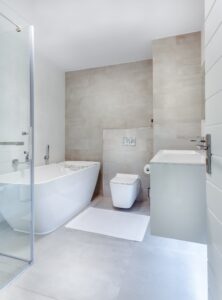The age-old debate on whether to tile the entire bathroom or opt for a more selective approach has been a common dilemma for homeowners undertaking bathroom renovations. Tiling, with its myriad of options in colors, sizes, and materials, is a fundamental aspect of bathroom design. In this article, we explore the pros and cons of tiling the entire bathroom to help you make an informed decision on whether this approach is a worthwhile investment or a potential design overkill.
The Case for Tiling the Whole Bathroom:
- Aesthetics and Cohesiveness: Tiling the entire bathroom creates a cohesive and visually appealing space. The continuity of the tile design, whether it’s a classic subway pattern or a modern mosaic, can contribute to a sense of unity and flow. This design choice is particularly effective in smaller bathrooms, making them appear larger and more harmonious.
- Easy Maintenance: A fully tiled bathroom is not only aesthetically pleasing but also practical in terms of maintenance. Tiled surfaces are easy to clean, and the lack of grout lines on large wall and floor areas minimizes the accumulation of dirt and grime. This makes for a more hygienic and low-maintenance bathroom environment.

- Water Resistance: Bathrooms are inherently humid spaces, making water resistance a crucial consideration. Tiling the entire bathroom provides a protective barrier against moisture, reducing the risk of water damage to walls and floors. This is especially important in areas prone to splashes, such as around the shower or bathtub.
- Increased Property Value: A well-designed and fully tiled bathroom can significantly enhance the resale value of your home. Potential buyers often view a fully tiled bathroom as a premium feature, associating it with a sense of luxury and attention to detail.
- Versatility in Design: With an extensive array of tile options available, tiling the entire bathroom allows for versatile design possibilities. From classic ceramic tiles to trendy geometric patterns or luxurious marble, the choices are limitless. This versatility empowers homeowners to create a personalized and timeless aesthetic.
Considerations Against Tiling the Whole Bathroom:
- Cost: One of the primary considerations against tiling the entire bathroom is the cost. Quality tiles, especially if you opt for premium materials, can be expensive. Factor in not just the cost of the tiles but also the labor for installation. Tiling the entire bathroom can quickly escalate the overall renovation budget.
- Design Overload: While a fully tiled bathroom can be visually appealing, there is a risk of design overload, especially if bold or intricate patterns are used. Too much visual stimulation can make the space feel overwhelming rather than inviting. It’s crucial to strike a balance and consider the size and natural light in the bathroom.
- Cold and Sterile Perception: Some homeowners worry that an all-tile bathroom may feel cold or sterile. While this can be mitigated by incorporating warmer elements like wood or textiles, it’s essential to carefully select the type and color of tiles to create a welcoming atmosphere.
- Installation Challenges: Tiling the entire bathroom requires meticulous installation, especially around corners, edges, and fixtures. If not done properly, it can result in an uneven or unprofessional finish. Hiring an experienced and skilled tile installer is crucial to achieving a polished look.
Finding the Middle Ground:
If you find yourself torn between the desire for a fully tiled bathroom and the practical considerations and potential drawbacks, consider finding a middle ground. Here are a few suggestions:
- Focus on Key Areas: Instead of tiling the entire bathroom, focus on key areas that benefit the most from tiled surfaces, such as the shower or bathtub surround. This allows you to enjoy the aesthetic and practical benefits of tiling without the high cost of covering the entire space.
- Accent Walls: Create visual interest by incorporating tiled accent walls. This approach allows you to showcase a unique tile design without overwhelming the entire space. It’s a cost-effective way to introduce texture and color.
- Floor-to-Ceiling Tiling in Wet Areas: Prioritize floor-to-ceiling tiling in areas prone to moisture, such as around the shower or bathtub. This ensures water resistance while minimizing the overall tile quantity and cost.
Conclusion:
The decision to tile the entire bathroom or adopt a more selective approach ultimately depends on your aesthetic preferences, budget, and practical considerations. While a fully tiled bathroom offers numerous benefits in terms of aesthetics, maintenance, and property value, it’s crucial to strike a balance that aligns with your personal style and the functional needs of the space. Consider consulting with a professional designer to explore creative options that enhance the visual appeal of your bathroom while staying within your budget constraints. Whether you choose to go all-in with tiles or adopt a more measured approach, the key is to create a space that reflects your taste and enhances your overall living experience.

